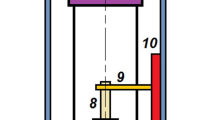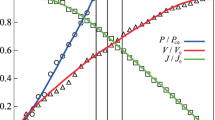Abstract
The dynamics of infiltration of a nanoporous body with a nonwetting liquid under rapid compression is studied experimentally and theoretically. Experiments are carried out on systems formed by a hydrophobic nanoporous body Libersorb 23, water, and an aqueous solution of CaCl2 at a compression rate of \( \dot p \) ≥ 104 atm/s. It is found that the infiltration begins and occurs at a new constant pressure independent of the compression energy and viscosity of the liquid. The time of infiltration and the filled volume increase with the compression energy. A model of infiltration of a nanoporous body with a nonwetting liquid is constructed; using this model, infiltration is described as a spatially nonuniform process with the help of distribution functions for clusters formed by pores accessible to infiltration and filled ones. On the basis of the proposed system of kinetic equations for these distribution functions, it is shown that under rapid compression, the infiltration process must occur at a constant pressure p c whose value is controlled by a new infiltration threshold θ c = 0.28 for the fraction of accessible pores, which is higher than percolation threshold θ c0 = 0.18. Quantity θ c is a universal characteristic of porous bodies. In the range θ c0 < θ < θ c , infiltration of the porous body should not be observed. It is shown that the solution to the system of kinetic equations leads to a nonlinear response by the medium to an external action (rapid compression), which means the compensation of this action by percolation of the liquid from clusters of filled pores of finite size to an infinitely large cluster of accessible but unfilled pores. As a result of such compensation, infiltration is independent of the viscosity of the liquid. It is found that all experimental results can be described quantitatively in the proposed model.
Similar content being viewed by others
References
M. Sahimi, Rev. Mod. Phys. 65, 1393 (1993).
A. H. Thompson, A. J. Katz, and R. A. Raschke, Phys. Rev. Lett. 58, 29 (1987).
J. Feder, Fractals (Plenum, New York, 1988; Mir, Moscow, 1991).
V. N. Bogomolov, Usp. Fiz. Nauk 124, 171 (1978) [Sov. Phys.—Usp. 21, 77 (1978)].
A. Yu. Fadeev and V. A. Eroshenko, Ross. Khim. Zh. 39(6), 93 (1995); V. A. Eroshenko and A. Yu. Fadeev, Zh. Fiz. Khim. 70 (8), 1482 (1996) [Russ. J. Phys. Chem. 70 (8), 1380 (1996)].
G. P. Matthews, C. J. Ridgway, and M. C. Spearing, J. Colloid Interface Sci. 171, 8 (1995).
J. Kloubek, J. Colloid Interface Sci. 163, 10 (1994).
V. D. Borman, A. M. Grekhov, and V. I. Troyan, Zh. Éksp. Teor. Fiz. 118(1), 193 (2000) [JETP 91 (1), 170 (2000)].
X. Kong, F. B. Surani, and Y. Qiao, J. Mater. Res. 20, 1042 (2005).
Y. Qiao and X. Kong, Phys. Scr. 71, 27 (2005).
F. B. Surani, X. Kong, and Y. Qiao, Appl. Phys. Lett. 87, 251906 (2005).
Y. Qiao and X. Kong, Phys. Scr. 71, 27 (2005).
X. Kong and Y. Qiao, Appl. Phys. Lett. 86, 151919 (2005).
C. V. Suciu, T. Iwatsubo, and S. Deki, J. Colloid Interface Sci. 259, 62 (2003).
A. Han, X. Kong, and Y. Qiao, J. Appl. Phys. 100, 014308 (2006).
F. B. Surani and Y. Qiao, J. Appl. Phys. 100, 034311 (2006).
F. B. Surani, A. Han, and Y. Qiao, Appl. Phys. Lett. 89, 093 108 (2006).
X. Chen, F. B. Surani, X. Kong, et al., Appl. Phys. Lett. 89, 241 918 (2006).
X. Kong and Y. Qiao, J. Appl. Phys. 99, 064 313 (2006).
V. D. Borman, A. A. Belogorlov, A. M. Grekhov, G. V. Lisichkin, V. N. Tronin, and V. I. Troyan, Zh. Éksp. Teor. Fiz. 127(2), 431 (2005) [JETP 100 (2), 385 (2005)].
L. E. Nielsen and R. F. Lande, Mechanical Properties of Polymers and Composites (Marcell Dekker, New York, 1993).
V. N. Bogomolov, Phys. Rev. B: Condens. Matter 51, 17040 (1995).
V. D. Borman, A. A. Belogorlov, A. M. Grekhov, G. V. Lisichkin, V. N. Tronin, and V. I. Troyan, Pis’ma Zh. Tekh. Fiz. 30(23), 1 (2004) [Tech. Phys. Lett. 30 (12), 973 (2004)].
B. I. Shklovskii and A. L. Efros, Electronic Properties of Doped Semiconductors (Nauka, Moscow, 1979; Springer, Berlin, 1984).
M. B. Isichenko, Rev. Mod. Phys. 64, 961 (1992).
F. B. Surani, X. Kong, D. B. Panchal, and Y. Qiao, Appl. Phys. Lett. 87, 163 111 (2005).
V. D. Borman, A. A. Belogorlov, A. M. Grekhov, V. N. Tronin, and V. I. Troyan, Pis’ma Zh. Éksp. Teor. Fiz. 74(5), 287 (2001) [JETP Lett. 74 (5), 258 (2001)].
K. S. Basniev, I. N. Kochina, and V. M. Maksimov, Underground Hydromechanics (Nedra, Moscow, 1993) [in Russian].
The Chemistry of Grafted Surface Compounds, Ed. by G. V. Lisichkin (Fizmatlit, Moscow, 2003) [in Russian].
Handbook of Physical Quantities, Ed. by I. S. Grigoriev and E. Z. Meilikhov (Énergoatomizdat, Moscow, 1991; CRC Press, Boca Raton, FL, United States, 1997).
Handbook of Chemistry and Physics, Ed. by D. R. Lide (CRC Press, London, 1994).
Yu. Yu. Tarasevich, Percolation: Theory, Applications, and Algorithms (URSS, Moscow, 2002).
A. A. Abrikosov, Pis’ma Zh. Éksp. Teor. Fiz. 29(1), 72 (1979) [JETP Lett. 29 (1), 65 (1979)].
P. M. Morse and H. Feshbach, Methods of Theoretical Physics (McGraw-Hill, New York, 1953; Inostrannaya Literatura, Moscow, 1958), Vol. 2.
Author information
Authors and Affiliations
Corresponding author
Additional information
Original Russian Text © V.D. Borman, A.A. Belogorlov, G.V. Lisichkin, V.N. Tronin, V.I. Troyan, 2009, published in Zhurnal Éksperimental’noĭ i Teoreticheskoĭ Fiziki, 2009, Vol. 135, No. 3, pp. 446–469.
Rights and permissions
About this article
Cite this article
Borman, V.D., Belogorlov, A.A., Lisichkin, G.V. et al. Investigation of the dynamics of a percolation transition under rapid compression of a nanoporous body-nonwetting liquid system. J. Exp. Theor. Phys. 108, 389–410 (2009). https://doi.org/10.1134/S1063776109030042
Received:
Accepted:
Published:
Issue Date:
DOI: https://doi.org/10.1134/S1063776109030042




